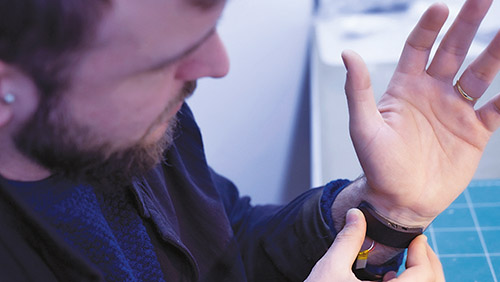
Wearable Devices is an innovative company at the forefront of an exciting industry positioned for major growth. An Israeli startup, they are developing the sort of technology that’s usually reserved for sci-fi movies and that has the potential to set the standard input interface for the metaverse. Their feature business-to-consumer product, the Mudra Band, is an Apple Watch aftermarket attachment that uses electrodes to non-invasively track neural activity through the skin, allowing users to operate their device using subtle hand movements without touching the device at all.
Wearable Devices is helmed by three seasoned tech experts: CEO Asher Dahan, President and Chief Scientist Guy Wagner, and Chief Technology Officer Leeor Langer, all dedicated to progress and innovation. Their technology is cutting-edge, and they recently completed their initial public offering to list on The Nasdaq Stock Market under the ticker symbol ‘WLDS.’ Teaneck resident Barry Kaplan is their executive vice president, and the team’s biggest cheerleader.
“Wearable Devices makes the impossible possible,” Kaplan shared with The Jewish Link. “Our team is composed of true geniuses who are constantly looking for ways to make life better and more exciting.”

The applications with the Mudra Band are numerous. It can serve as a non-invasive human-machine interfacing machine, which is much more preferable to surgical solutions and implants.
“Augmented reality and virtual reality require controllers; we are that controller,” Kaplan continued. “Apple Watches have a band that serves no purpose other than functionality. We replace the band and offer potential neural control over any Bluetooth-compatible device with precise gestural and pressure sensitivity. Imagine, five years from now, architecting an entire building in virtual or augmented 3D space with two Mudra Bands—one on each wrist!”
A particularly interesting and innovative feature of the Mudra Band is that it can be operated by amputees. Because the band reads neural messages sent by the brain, the device can still process neural signals and transfer them into actions, even if there are no physical limbs or fingers that correspond to a particular signal.
“The whole idea for the devices came from the hypothetical idea of turning intention into action,” Kaplan said. “What if a device could read my neural activity and translate it into a command? So our guys said, ‘Our nervous system travels throughout our body. What if we could find a way to use that, since the nerves go to the brain?’ So they went to work and created a device that uses electrodes under the wrist so that when a finger is moved, the device recognizes it.”

Israel has become one of the premier markets for technological innovation in recent years. Kaplan sees this as a natural progression, since the country has become so synonymous with progress.
“I remember recently reading that 11% of Israel’s national economy is now in high-tech,” he said. “The number of Israeli patent holders is rising exponentially, and Wearable Devices currently has three, with even more potentially planned for the future. If the current trend continues, Tel Aviv will soon be the biggest tech hub in the world. I’m encouraging my children to become engineers and business savvy, because God willing, the next decade at the very least will be super-exciting for technologists and budding technologists, in Israel especially.”
As for how Kaplan came to work with Wearable Devices, he said it all began at a conference he was attending in 2017.
“I was distributing one of our luxury watch brands at BaselWorld 2017, then the biggest watch and jewelry show in the world. I was in one of the conference rooms discussing a new contract with an existing distributor when two of my colleagues came in and said that an Orthodox Jew was waiting in our guest lounge with a new kind of technology that they had never seen before. It was not of interest to them, but something they thought I personally would find interesting.”

Kaplan, who described himself as a “part-time futurist,” was intrigued and wanted to learn more.
“My meeting concluded and I saw Asher Dahan, the current CEO of Wearable Devices, demonstrate brain waves on his phone from simple finger movements and a blue strap on his wrist. It seemed like something out of a sci-fi movie. Asher had stopped at our booth because he saw kippahs, not something commonly found at a European trade show. One thing led to another and soon I was spearheading an early round of investment in the company. I became a board member in July 2017 and have been EVP since July 2021.”
Since then, Kaplan has had a front-row seat to the company’s progress. While there are exciting innovations he is not yet able to discuss, he promises that big things are to come from Wearable Devices.
“It’s just a really exciting space to get to work in,” Kaplan said. “I joke with my family that the team I work with are bringing the future closer. I’m very excited about the things that are to come. For now, all I can say is I really believe that 10 years from now people will refer to Mudra Band like they refer today to the mouse; it will be that pervasive. We are right here at the beginning of a revolution in neural and input control.”

To learn more about Wearable Devices, visit their website, wearabledevices.co.il. Additionally, to learn more about the Mudra Band, visit www.mudra-band.com.
Adam Samuel is a journalist from Teaneck. He blogs at www.adamssoapbox.com.










